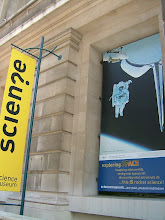The Age of Entanglement: When Quantum Physics Was Reborn - Louisa Gilder
Miss Gilder's forthcoming book stars Einstein, Schrödinger, Bell, Bohr, Heisenberg, de Broglie, and other giants. From the 26th Annual Meeting of Doctors for Disaster Preparedness, held July 12, 2008, in Mesa, AZ.
2010/09/19
2010/09/05
Introduction of my dissertation (I)
The ability to convert an intiution into a formulation is what I obtain most during my PhD career. It was a long and lonely journey. I can’t stop thinking what causes the gap between complex mechanics and nowadays physics society. A simple question leads me to ponder over my research topic for dissertation. My intuition helps me a lot during dealing with this issue. Before I can discuss it, I did a survey to see how other classical approaches to quantum mechanics could or could not dismiss this gap.
Among all classical approaches, the quantum Hamilton-Jacobi formalism is the oldest one, which is discussed even as the same time quantum mechanics is established. Indeed, if we compare complex mechanics to the quantum H-J formalism, we will find out that at least, both theories have the same mathematical route-they all insert the wave function into the Schrodinger equation. The only difference is that the complex space structure is an assumption of the former, and a consqauece of the later. This difference did causes the gap because of the acceptance of complex space is not avariable in conventional physics field. I think it might not be the best choice to over emphasize the importance of considering complex space instead of real space that we could observe. There will be a lot of criticisms and demands for the evidence of proving the existence of complex space. This is the position where a pike meets a shield.
We shall define our issue in a physical interpretation or a mathematical interpretation at beginning. It becomes reasonable and might be an easier way to emphasize complex space if viewed mathematically. But in such a way, it totally disobeys the original thought provided by Prof. Yang that is our living world is complex. It becomes more difficult if we adopt a physical manner as to challenge the dimension of the space structure. I found out that maybe I can have both ways in the discussion of this issue in my dissertation, and leave the definition to the reader. I imply the necessary of consider a complex-valued wave function instead a regular one, and indicate the advantage of doing so. I try to avoid bringing the critical part into discussion, and try to show readers the complex space is naturally arose mathematically and physically.
My intuition tells me that the additional irregular velocity appeared in Bohm’s modified guidance law is originated from the imaginary subspace. Even Prof. Yang did mention this conjecture in his text book, however, only a simple relation is presented. We need a better understanding, or a derivation in detail, to confirm this conjecture. I found out that the form of the wave functions adopted in H-J formalism, or complex mechanics, and in Bohmian mechanics have an intense relationship. The wave function used in H-J formalism focuses on the action function; while the other form considers the magnitude and the phase most in Bohmian mechanics. In fact, the relationship between the quantum action function and the characteristic of the wave function is so important, which has been ignored by everyone. This is how I can verify the conjecture that the irregular motion is originated from the imaginary of the wave function.
A classical wave picture is mentioned in quantum H-J formalism and Bohmian mechanics, but not in complex mechanics. I am not sure the reason why there is no such a discussion in Prof. Yang’s text book, but I believe that it is an important issue and needed to be discussed within complex mechanics. In quantum H-J formalism, the Hamilton’s original wave picture is proposed in terms of the reconstruction of the wave function from the quantum action function. However, they did not interpret this process in detail. In Bohmian mechanics, Bohm proposed an assumption that the initial condition of the fluid must be taken otherwise the continuity equation cannot be satisfied. I do believe that a suitable interpretation in terms of trajectories can be given by complex mechanics. However, an important product came out in the middle way. The Born’s postulate of the quantum probability density can be derived from the energy conservation of the imaginary subspace. It quite makes sense since the continuity equation of probability density is from the imaginary part of the Schrodinger equation (after inserting the wave function).
Among all classical approaches, the quantum Hamilton-Jacobi formalism is the oldest one, which is discussed even as the same time quantum mechanics is established. Indeed, if we compare complex mechanics to the quantum H-J formalism, we will find out that at least, both theories have the same mathematical route-they all insert the wave function into the Schrodinger equation. The only difference is that the complex space structure is an assumption of the former, and a consqauece of the later. This difference did causes the gap because of the acceptance of complex space is not avariable in conventional physics field. I think it might not be the best choice to over emphasize the importance of considering complex space instead of real space that we could observe. There will be a lot of criticisms and demands for the evidence of proving the existence of complex space. This is the position where a pike meets a shield.
We shall define our issue in a physical interpretation or a mathematical interpretation at beginning. It becomes reasonable and might be an easier way to emphasize complex space if viewed mathematically. But in such a way, it totally disobeys the original thought provided by Prof. Yang that is our living world is complex. It becomes more difficult if we adopt a physical manner as to challenge the dimension of the space structure. I found out that maybe I can have both ways in the discussion of this issue in my dissertation, and leave the definition to the reader. I imply the necessary of consider a complex-valued wave function instead a regular one, and indicate the advantage of doing so. I try to avoid bringing the critical part into discussion, and try to show readers the complex space is naturally arose mathematically and physically.
My intuition tells me that the additional irregular velocity appeared in Bohm’s modified guidance law is originated from the imaginary subspace. Even Prof. Yang did mention this conjecture in his text book, however, only a simple relation is presented. We need a better understanding, or a derivation in detail, to confirm this conjecture. I found out that the form of the wave functions adopted in H-J formalism, or complex mechanics, and in Bohmian mechanics have an intense relationship. The wave function used in H-J formalism focuses on the action function; while the other form considers the magnitude and the phase most in Bohmian mechanics. In fact, the relationship between the quantum action function and the characteristic of the wave function is so important, which has been ignored by everyone. This is how I can verify the conjecture that the irregular motion is originated from the imaginary of the wave function.
A classical wave picture is mentioned in quantum H-J formalism and Bohmian mechanics, but not in complex mechanics. I am not sure the reason why there is no such a discussion in Prof. Yang’s text book, but I believe that it is an important issue and needed to be discussed within complex mechanics. In quantum H-J formalism, the Hamilton’s original wave picture is proposed in terms of the reconstruction of the wave function from the quantum action function. However, they did not interpret this process in detail. In Bohmian mechanics, Bohm proposed an assumption that the initial condition of the fluid must be taken otherwise the continuity equation cannot be satisfied. I do believe that a suitable interpretation in terms of trajectories can be given by complex mechanics. However, an important product came out in the middle way. The Born’s postulate of the quantum probability density can be derived from the energy conservation of the imaginary subspace. It quite makes sense since the continuity equation of probability density is from the imaginary part of the Schrodinger equation (after inserting the wave function).
訂閱:
文章 (Atom)








